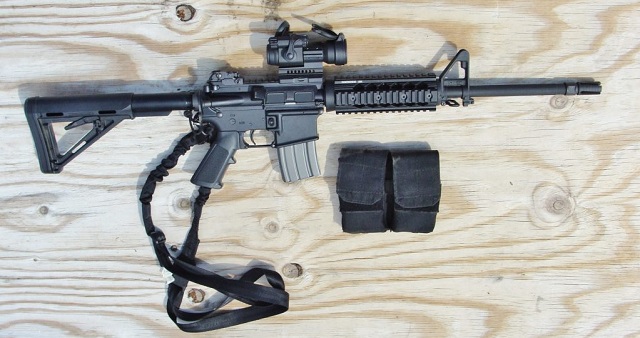
Tactical firearm accessories have been popular for a while, and slings are no exception. Slings, of course, are far from new. Military long arms have featured sling systems for centuries, and many of today’s sporting slings still follow the earliest designs that employed two connection points and a basic strap.
by Steve Markwith, author of Centerfire Rifles: A Buyer’s and Shooter’s Guide
Not to be confused with some loop designs intended to increase stability during rifle competitions, traditional slings just relieve the carry burden of a firearm by draping it over a shoulder. Further benefits include safer vertical carry in the company of others, and the freeing of hands for various minor tasks. Some tasks could be one-handed, like watering the bushes or fishing in a pocket for a set of keys. Two hands work better when scanning with binoculars or a rangefinder – also doable with a simple shoulder sling.
On the other hand, climbing, running, and other maneuvers can introduce greater challenges, especially in tactical environs. The need to rapidly address threats, transition to a handgun, and recover casualties also come into play. Several alternate sling systems have evolved to better cover these needs, but when narrowing down choices, muzzle management should be a determinant factor.
Slings and the Safety Factor
Before jumping into some type of tactical-type sling, it’s worth considering the main purpose of the firearm. This morning I lugged a turkey out of the woods with a shotgun slung over my right shoulder. Paradoxically, it was a Beretta Model 1301 Competition autoloader designed for three-gun matches with decidedly tactical slants. But, after screwing in a tight turkey choke and attaching a basic nylon sling, I suddenly had a handy woods gun. When it was time to set out a decoy I just propped the shotgun safely in the crotch of a tree.
No fuss, no bother – which leads to the subject of sling designs and their relationship with two highly relevant firearms safety rules:
#1: All guns are loaded – always! Commitment to “always” is the best insurance against sloppy handling.
#2: Don’t allow the muzzle to cover anything you’re unwilling to destroy! Feet and other parts of your anatomy qualify as “anything.” Same story regarding the body parts of others in your space.
There are a number of sling variations. Some, like those oriented toward AR systems, are configurable to different mission requirements. Often though, they are evolutions of a few common designs.
Single Point Slings Introduced
Intended primarily for use in tactical-type scenarios, most consist of a reinforced loop with a single QD-swivel, or a hook. The attachment point is typically somewhere near the rear of a firearm’s action. Those with swivels are usually push-release QD types that plug into a matching socket. The snap-hook variations clip on to a steel eyelet which may be integral to an AR’s rear receiver-plate, or a clamp-on accessory. Once attached, the sling-loop is passed over the user’s head and a shoulder, permitting the gun to hang muzzle-down.
Shorter firearms like collapsible-stock AR carbines (or pistols) are typical single-point candidates – but, so are some others. We (my agency) fielded a bunch of KEL TEC KSG shotguns for special operations, which were tethered securely to our operators via single-points. We found they carried well when slung, and also remained maneuverable thanks to the KSG’s short bull-pup configuration.
8 Problems with Single Point Slings on AR-15s
Next, we tried single-points while procuring new AR-15s similar to military M-4 carbines. Using one single-point sling connected to an operator’s vest, attachment to either weapon was a breeze. Although simple and quick to deploy, life was still not good. Here are the problems we found…

Problem #1 – Muzzle Control Problems (Rule #2)
By its design, the downward orientation of the dangling gun will position its muzzle near your feet. Odds are high at least one will be swept sooner, if not later. And, Rule #2 concerns don’t end here…
Problem #2 – Movement
Expect lots of “floppage” without one hand on the firearm. This may seem like no big deal, especially with pistol-grip ARs, which are easy to control during basic range activities. Start running around though and you can wind up with an energetic pendulum, and motivated movement will be likely as soon as things turn ugly. Yes, at that point the weapon will be on your hands, but it’s worth considering Murphy’s Law: Anything that can go wrong will go wrong – at the worst possible moment. Like a malfunction…
Problem #3 – Weapon Transitions
Defensive doctrine calls for a rapid transition to the handgun if stoppage can’t be cleared quickly. A proper tactical-type sling will permit the transition while maintaining its custody. Once the handgun clears the holster, use of both hands is likely.
Yeah, you could draw and shoot one-handed, possibly with some effect – while flat-footed. But most defensive situations are dynamic so, sooner or later, both hands will probably wind up on the handgun. During movement to somewhere more bullet-proof, plan on getting whacked in the jewels – as the muzzle swings in all directions. You’ll also wind up using both hands if reloads become necessary.
Problem #4 – Use of Cover
Assuming you’ve made it to some type of cover, pray it isn’t too short. If a crouch or kneeling position is required, the muzzle of your slung weapon will probably make hard muzzle-down contact with the ground. Beyond this disruption, a bore obstruction is possible on soft surfaces.
Even when life is good, the standard muzzle-down orientation can cause a bore obstruction. In my area we measure snow by the foot. Anything less than 6-inches is considered “nuisance snow.”
Problem #5 – Climbing
This one applies to both ninjas and sportsmen (or ladies). Tactical military and LEO types deal with more than steep terrain. Ladders and drawn handguns may be involved. At that point, a single-point sling can become a liability regarding balance and muzzle control. Elevated tree stands are popular with hunters, but at least they can (should) climb unloaded. Still, a there are better systems than single point slings for this one.
Problem #6 – Ground Work
Most positions below standing can create hassles, even safety issues. Dropped items can be dealt with. Treatment or recovery of downed casualties becomes complicated.
Problem #7 – Aiming Support
Even a basic strap-type sling can be wrapped around the support arm and tensioned to help steady a rifle. Good luck trying that with a single-point sling. It won’t do much.
Problem #8 – The Connection Point
The protruding ears on ARs and the associated sling hardware can cause some operational interference – and aggravation. Simple, clean lines are always preferred whenever possible.
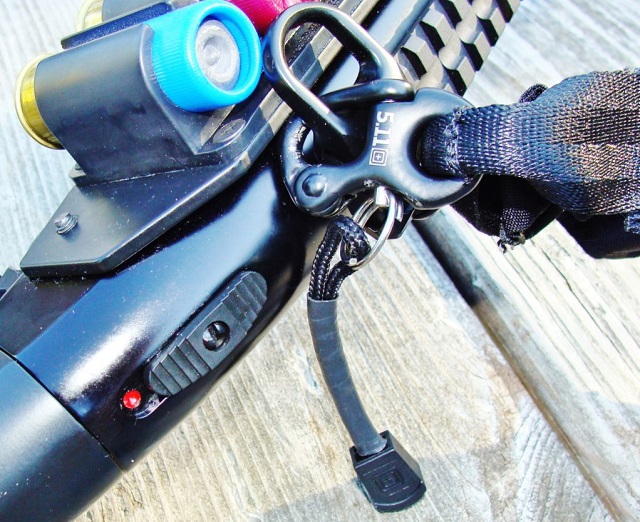
When to Use a Single Point Sling
So why use a single-point at all? Good question. Having used one during some fast-paced instructor-level programs, I will say this: Simplicity is its main virtue. Also, switching shoulders is easy, and maneuverability is good with short-barreled guns.
For this reason, I’ve thought about trying one with my suppressed .300 Blackout 10 ½” AR, just for slipping through thick woods. It would offer a fair compromise of carry comfort versus speed, while providing one free hand to ward off branches. Some ultra-short buzz guns are also dangled under coats for use by protective details. However, like the lanyard on a handgun, I’d consider a single-point more of a tether.
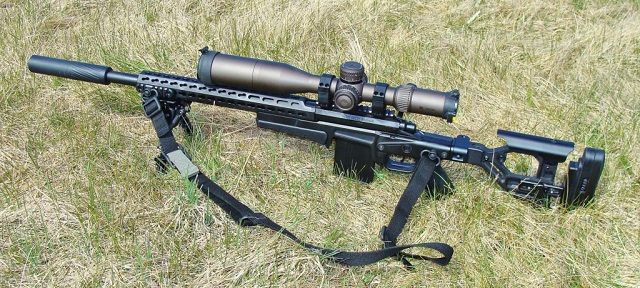
Two Point Sling Adaptations
Two point sling adaptations are a big improvement. No need to get overly fancy either. Go with a rig like the Viking Tactics version and you can check off all of the issues above – assuming it’s properly adjusted. That’s easy thanks to a section of the sling that can be instantly cinched up as necessary.
Normally, the firearm will hang cross-body, muzzle down, where it’s instantly available. If necessary, it can even be spun behind the back for climbing (absent a pack). Switching shoulders is doable and the V-Tac can also be used as for shooting support.
Related article: Single Point vs Two Point Slings
During carry, both hands are available. This system is mainly intended for collapsible-stock AR carbines, but it’ll work on other guns. Attachment points are the rear of the stock and forend, using several options including the above pictured QD push-button system.
If not incorporated into the gun, most ARs (and other firearms) can be set up with matching sockets via aftermarket systems. Attachment is also possible using QD sporting swivels, or by direct threading through sling-slots. For full appreciation of this system check out the V-Tac website, which has highly informative videos.
One potential two-point downside can be addressed through conscious observation of Rule #2. In close proximity to others, it’s possible to sweep lower extremities. Pay attention to the armed security personnel posted at various international airports and you’ll note passengers oblivious to this situation.
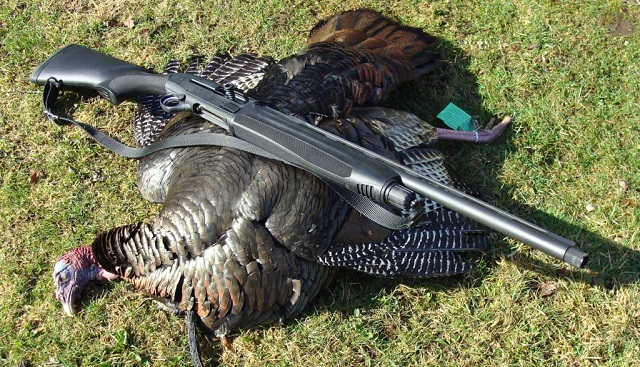
Basic Carry Straps
Today’s primary use involves sporting rifles and some shotguns, many of which come equipped for QD sling-swivels. I keep several pre-rigged nylon slings on hand in 1- or 1-1/2” widths, and rotate them among guns as needed. When carried conventionally, a muzzle will be exposed to the weather, and the barrel can snag overhead branches. Also, unless the shooting hand maintains control of the strap, it will begin to slip (although those with rubber facing help).
For this reason, if navigating tough terrain, some people increase the sling’s length (via the buckle) and pass it over their head. The gun will then wind up in a secure cross-back location at the expense of rapid deployment. You could climb a ladder stand using this technique and an empty gun, but don’t try this with a gun dangling from a shoulder. Better yet, hoist it empty once situated.
The Super Swivel types have an extra locking feature which prevents accidental depression of their small release-tabs. Detachment is still easy though. In some tight hunting spots, I’ll roll up a minimal nylon sling and then stash it in a coat pocket.
After exposure to wet weather, you can hang one in a warm spot until dry and give the swivels a shot of WD-40. The same sling will also serve as an effective shooting aid after wrapping it around you support arm. In a pinch, it can also facilitate transition to a handgun. Reach through the sling with the support hand palm down, grab the sling be the rear swivel, and toss the gun over your opposite shoulder like a coat. The long-gun will wind up facing rearward, muzzle down. Once both hands have acquired the handgun, it’ll stay put – if standing. Actually, this opposite-side carry technique often works better with a holstered handgun carried at the common 3:00 location. You can use it during bad weather, too, but I’d skip it on snow.
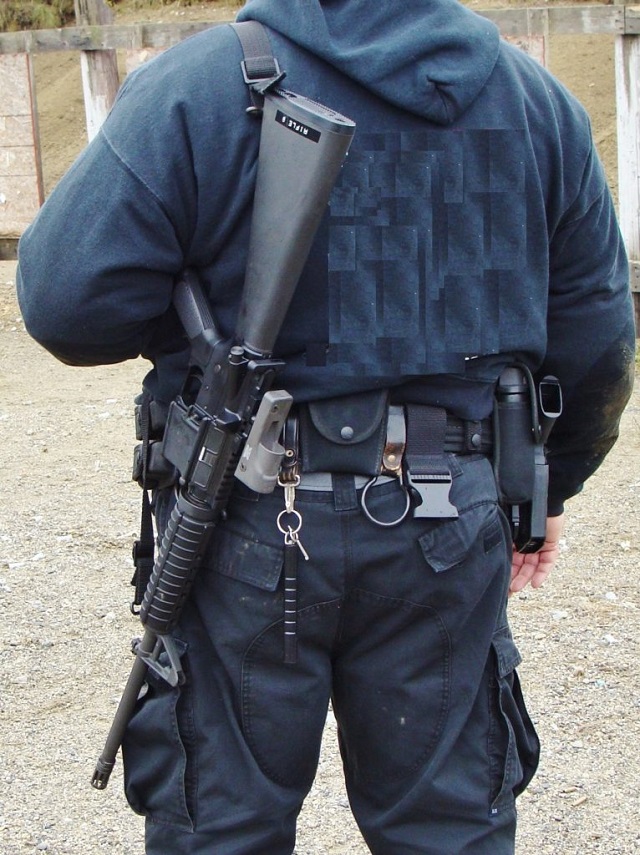
This type of sling is old-school but it could be all you need. One concern involves muzzle control. In proximity to others, watch where your muzzle points, especially if bending forward or when executing a dismount. Although grabbing the wrist of the stock and spinning the gun rearward is fast, anyone to your rear will be swept!
Sling Mounting Notes
The above mentioned sporting QD swivels, including the locking types, are sold by Grov-Tec, Uncle Mike’s, and right on Amazon. Tactical-type choices are almost mind-numbing and some are downright ingenious.
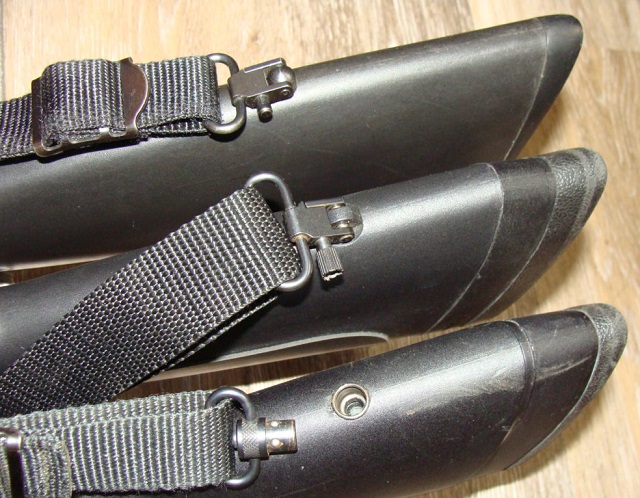
Closing Thoughts
Unlike the typical handgun carried in a holster, you become one-handed at best without a sling of some sort. But slings aren’t always good, or even necessary. I never use one with an upland shotgun because flushing game birds require maximum readiness, and a sling can become a liability in a vehicle, or a hindrance in some tight spots.
Of course, the beauty of a QD attachment system is that you can adapt as circumstances require. Pick the sling system most appropriate for your needs. Even if equipped with a quick-disconnect system, many of us will wind up owning more than one. Costs are fairly reasonable so that’s often the best route.
Want to learn a lot more about slings, optics, accessories and firearms in general?
See Steve Markwith’s full line of books at Prepper Press.

1 comment
I was rolling with single point for a while and it’s just the worst. All of the problems are spot on. I now have a basic two point sling attachment and it makes all the difference. Very thorough article!